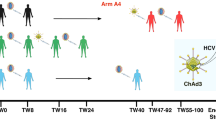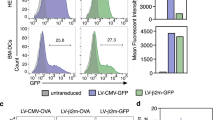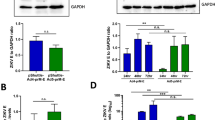Abstract
Recombinant adenoviral vectors (AdV) have been used experimentally as vaccines to present antigenic transgenes in vivo. However, administration of first-generation vectors (FG-AdV) is often limited by their induction of antiviral immunity. To address this limitation, helper-dependent vectors (HD-AdV) were developed that lack viral coding regions. While the administration of HD-AdV results in long-term gene expression in vivo, their utility as immunogens has never been examined. Direct vaccination with 108 blue-forming units (BFU) of HD-AdV injected into C57BL/6 mice lead to superior transgene-specific CTL and antibody responses when compared to the same amount of a FG-AdV. The antibody responses to viral antigens were high in response to both the vectors. As a mechanism to reduce viral exposure, dendritic cells (DC) were transduced with HD-AdV in vitro and then used as a cell-based vaccine. DC transduced with HD-AdV expressed higher levels of transgene-specific mRNA and up to 1200-fold higher levels of transgene protein than did DC transduced with a FG-AdV. In addition, HD-AdV-transduced DC stimulated superior transgene-specific CTL responses when administered in vivo, an effect that was further enhanced by maturing the DC with LPS prior to administration. In contrast to direct immunization with HD-AdV, vaccination with HD-AdV-transduced DC was associated with limited antibody responses against the AdV. We conclude that HD-AdV stimulates superior transgene-specific immune responses when compared to a FG-AdV, and that immunization with a DC-based vaccine maintains this efficacy while limiting antiviral reactivity.
This is a preview of subscription content, access via your institution
Access options
Subscribe to this journal
Receive 12 print issues and online access
$259.00 per year
only $21.58 per issue
Buy this article
- Purchase on Springer Link
- Instant access to full article PDF
Prices may be subject to local taxes which are calculated during checkout







Similar content being viewed by others
References
Russell WC . Update on adenovirus and its vectors. J Gen Virol 2000; 81: 2573–2604.
Yang Y et al. Inactivation of E2a in recombinant adenoviruses improves the prospect for gene therapy in cystic fibrosis. Nat Genet 1994; 7: 362–369.
Gilbert R et al. Improved performance of a fully gutted adenovirus vector containing two full-length dystrophin cDNAs regulated by a strong promoter. Mol Ther 2002; 6: 501–509.
Fisher KJ et al. Recombinant adenovirus deleted of all viral genes for gene therapy of cystic fibrosis. Virology 1996; 217: 11–22.
Kochanek S et al. A new adenoviral vector: replacement of all viral coding sequences with 28 kb of DNA independently expressing both full-length dystrophin and beta-galactosidase. Proc Natl Acad Sci USA 1996; 93: 5731–5736.
Parks RJ et al. A helper-dependent adenovirus vector system: removal of helper virus by Cre-mediated excision of the viral packaging signal. Proc Natl Acad Sci USA 1996; 93: 13565–13570.
Roth MD et al. Helper-dependent adenoviral vectors efficiently express transgenes in human dendritic cells but still stimulate antiviral immune responses. J Immunol 2002; 169: 4651–4656.
Maione D et al. Prolonged expression and effective readministration of erythropoietin delivered with a fully deleted adenoviral vector. Hum Gene Ther 2000; 11: 859–868.
Maione D et al. An improved helper-dependent adenoviral vector allows persistent gene expression after intramuscular delivery and overcomes preexisting immunity to adenovirus. Proc Natl Acad Sci USA 2001; 98: 5986–5991.
Mosmann TR, Sad S . The expanding universe of T-cell subsets: Th1, Th2 and more. Immunol Today 1996; 17: 138–146.
Melief CJ et al. Effective therapeutic anticancer vaccines based on precision guiding of cytolytic T lymphocytes. Immunol Rev 2002; 188: 177–182.
Ribas A et al. Genetic immunization for the melanoma antigen MART-1/Melan-A using recombinant adenovirus-transduced murine dendritic cells. Cancer Res 1997; 57: 2865–2869.
Arthur JF et al. A comparison of gene transfer methods in human dendritic cells. Cancer Gene Ther 1997; 4: 17–25.
Molinier-Frenkel V et al. Adenovirus hexon protein is a potent adjuvant for activation of a cellular immune response. J Virol 2002; 76: 127–135.
Miller G et al. Adenovirus infection enhances dendritic cell immunostimulatory properties and induces natural killer and T-cell-mediated tumor protection. Cancer Res 2002; 62: 5260–5266.
Basak S et al. Colorectal cancer vaccines: antiidiotypic antibody, recombinant protein, and viral vector. Ann NY Acad Sci 2000; 910: 237–252; discussion 252–253.
Steitz J et al. Genetic immunization of mice with human tyrosinase-related protein 2: implications for the immunotherapy of melanoma. Int J Cancer 2000; 86: 89–94.
Schmitz H, Wigand R, Heinrich W . Worldwide epidemiology of human adenovirus infections. Am J Epidemiol 1983; 117: 455–466.
DeMatteo RP et al. Cellular immunity delimits adenoviral gene therapy strategies for the treatment of neoplastic diseases. Ann Surg Oncol 1999; 6: 88–94.
Siemens DR et al. Cutting edge: restoration of the ability to generate CTL in mice immune to adenovirus by delivery of virus in a collagen-based matrix. J Immunol 2001; 166: 731–735.
Yang Y et al. Cellular and humoral immune responses to viral antigens create barriers to lung-directed gene therapy with recombinant adenoviruses. J Virol 1995; 69: 2004–2015.
Morsy MA et al. An adenoviral vector deleted for all viral coding sequences results in enhanced safety and extended expression of a leptin transgene. Proc Natl Acad Sci USA 1998; 95: 7866–7871.
Zou L et al. Helper-dependent adenoviral vector-mediated gene transfer in aged rat brain. Hum Gene Ther 2001; 12: 181–191.
Parks RJ et al. Effects of stuffer DNA on transgene expression from helper-dependent adenovirus vectors. J Virol 1999; 73: 8027–8034.
O'Neal WK et al. Toxicity associated with repeated administration of first-generation adenovirus vectors does not occur with a helper-dependent vector. Mol Med 2000; 6: 179–195.
Mercier S et al. Distinct roles of adenovirus vector-transduced dendritic cells, myoblasts, and endothelial cells in mediating an immune response against a transgene product. J Virol 2002; 76: 2899–2911.
Bronte V et al. Antigen expression by dendritic cells correlates with the therapeutic effectiveness of a model recombinant poxvirus tumor vaccine. Proc Natl Acad Sci USA 1997; 94: 3183–3188.
Condon C et al. DNA-based immunization by in vivo transfection of dendritic cells. Nat Med 1996; 2: 1122–1128.
Porgador A et al. Predominant role for directly transfected dendritic cells in antigen presentation to CD8+ T cells after gene gun immunization. J Exp Med 1998; 188: 1075–1082.
Song W et al. Dendritic cells genetically modified with an adenovirus vector encoding the cDNA for a model antigen induce protective and therapeutic antitumor immunity. J Exp Med 1997; 186: 1247–1256.
Wan Y et al. Dendritic cells transduced with an adenoviral vector encoding a model tumor-associated antigen for tumor vaccination. Hum Gene Ther 1997; 8: 1355–1363.
Wan Y et al. Murine dendritic cells transduced with an adenoviral vector expressing a defined tumor antigen can overcome anti-adenovirus neutralizing immunity and induce effective tumor regression. Int J Oncol 1999; 14: 771–776.
Nikitina EY et al. An effective immunization and cancer treatment with activated dendritic cells transduced with full-length wild-type p53. Gene Therapy 2002; 9: 345–352.
Castiglioni P et al. Cross-priming is under control of the relB gene. Scand J Immunol 2002; 56: 219–223.
Mincheff M et al. In vivo transfection and/or cross-priming of dendritic cells following DNA and adenoviral immunizations for immunotherapy of cancer – changes in peripheral mononuclear subsets and intracellular IL-4 and IFN-gamma lymphokine profile. Crit Rev Oncol Hematol 2001; 39: 125–132.
Labeur MS et al. Generation of tumor immunity by bone marrow-derived dendritic cells correlates with dendritic cell maturation stage. J Immunol 1999; 162: 168–175.
Aiba S, Tagami H . Dendritic cell activation induced by various stimuli, eg exposure to microorganisms, their products, cytokines, and simple chemicals as well as adhesion to extracellular matrix. J Dermatol Sci 1998; 20: 1–13.
Manome H, Aiba S, Tagami H . Simple chemicals can induce maturation and apoptosis of dendritic cells. Immunology 1999; 98: 481–490.
Rescigno M et al. Dendritic cell maturation is required for initiation of the immune response. J Leukoc Biol 1997; 61: 415–421.
Verhasselt V et al. Bacterial lipopolysaccharide stimulates the production of cytokines and the expression of costimulatory molecules by human peripheral blood dendritic cells: evidence for a soluble CD14-dependent pathway. J Immunol 1997; 158: 2919–2925.
Morelli AE et al. Cytokine production by mouse myeloid dendritic cells in relation to differentiation and terminal maturation induced by lipopolysaccharide or CD40 ligation. Blood 2001; 98: 1512–1523.
Cella M et al. Ligation of CD40 on dendritic cells triggers production of high levels of interleukin-12 and enhances T cell stimulatory capacity: T–T help via APC activation. J Exp Med 1996; 184: 747–752.
Fu YX, Chaplin DD . Development and maturation of secondary lymphoid tissues. Annu Rev Immunol 1999; 17: 399–433.
Hirschowitz EA et al. Murine dendritic cells infected with adenovirus vectors show signs of activation. Gene Therapy 2000; 7: 1112–1120.
Korst RJ et al. Effect of adenovirus gene transfer vectors on the immunologic functions of mouse dendritic cells. Mol Ther 2002; 5: 307–315.
Rea D et al. Adenoviruses activate human dendritic cells without polarization toward a T-helper type 1-inducing subset. J Virol 1999; 73: 10245–10253.
Rescigno M et al. Dendritic cell survival and maturation are regulated by different signaling pathways. J Exp Med 1998; 188: 2175–2180.
Berberich I, Shu GL, Clark EA . Cross-linking CD40 on B cells rapidly activates nuclear factor-kappa B. J Immunol 1994; 153: 4357–4366.
Okada N et al. Efficient gene delivery into dendritic cells by fiber-mutant adenovirus vectors. Biochem Biophys Res Commun 2001; 282: 173–179.
Rea D et al. Highly efficient transduction of human monocyte-derived dendritic cells with subgroup B fiber-modified adenovirus vectors enhances transgene-encoded antigen presentation to cytotoxic T cells. J Immunol 2001; 166: 5236–5244.
Tillman BW et al. Adenoviral vectors targeted to CD40 enhance the efficacy of dendritic cell-based vaccination against human papillomavirus 16-induced tumor cells in a murine model. Cancer Res 2000; 60: 5456–5463.
Grave L et al. Differential influence of the E4 adenoviral genes on viral and cellular promoters. J Gene Med 2000; 2: 433–443.
Gilbert R et al. Dystrophin expression in muscle following gene transfer with a fully deleted (‘gutted’) adenovirus is markedly improved by trans-acting adenoviral gene products. Hum Gene Ther 2001; 12: 1741–1755.
Basak SK et al. Increased dendritic cell number and function following continuous in vivo infusion of granulocyte macrophage-colony-stimulating factor and interleukin-4. Blood 2002; 99: 2869–2879.
Sato M et al. Replication and packaging of helper-dependent adenoviral vectors. Gene Therapy 2002; 9: 472–476.
Harui A et al. Frequency and stability of chromosomal integration of adenovirus vectors. J Virol 1999; 73: 6141–6146.
Inaba K et al. Generation of large numbers of dendritic cells from mouse bone marrow cultures supplemented with granulocyte/macrophage colony-stimulating factor. J Exp Med 1992; 176: 1693–1702.
Ribas A et al. CD40 cross-linking bypasses the absolute requirement for CD4 T cells during immunization with melanoma antigen gene-modified dendritic cells. Cancer Res 2001; 61: 8787–8793.
Michou AI et al. Adenovirus-mediated gene transfer: influence of transgene, mouse strain and type of immune response on persistence of transgene expression. Gene Therapy 1997; 4: 473–482.
Croyle MA et al. Stealth adenoviruses blunt cell-mediated and humoral immune responses against the virus and allow for significant gene expression upon readministration in the lung. J Virol 2001; 75: 4792–4801.
Acknowledgements
Supported by grants from the Tobacco-Related Disease Research Program of California (SKB, 10KT-0086; MDR, #7RT-0040); the American Lung Association of California (SKB); the UCLA Gene Therapy Program (SMK); and the UCLA Lung Cancer SPORE (NIH/NCI 1 P50 CA090388).
Author information
Authors and Affiliations
Rights and permissions
About this article
Cite this article
Harui, A., Roth, M., Kiertscher, S. et al. Vaccination with helper-dependent adenovirus enhances the generation of transgene-specific CTL. Gene Ther 11, 1617–1626 (2004). https://doi.org/10.1038/sj.gt.3302332
Received:
Accepted:
Published:
Issue Date:
DOI: https://doi.org/10.1038/sj.gt.3302332
Keywords
This article is cited by
-
Intranasal immunization with a helper-dependent adenoviral vector expressing the codon-optimized fusion glycoprotein of human respiratory syncytial virus elicits protective immunity in BALB/c mice
Virology Journal (2013)
-
Shutdown of immunological priming and presentation after in vivo administration of adenovirus
Gene Therapy (2012)
-
Reconstitution of huPBL-NSG Mice with Donor-Matched Dendritic Cells Enables Antigen-Specific T-cell Activation
Journal of Neuroimmune Pharmacology (2011)
-
Readministration of helper-dependent adenovirus to mouse lung
Gene Therapy (2006)
-
Gutless adenovirus: last-generation adenovirus for gene therapy
Gene Therapy (2005)



